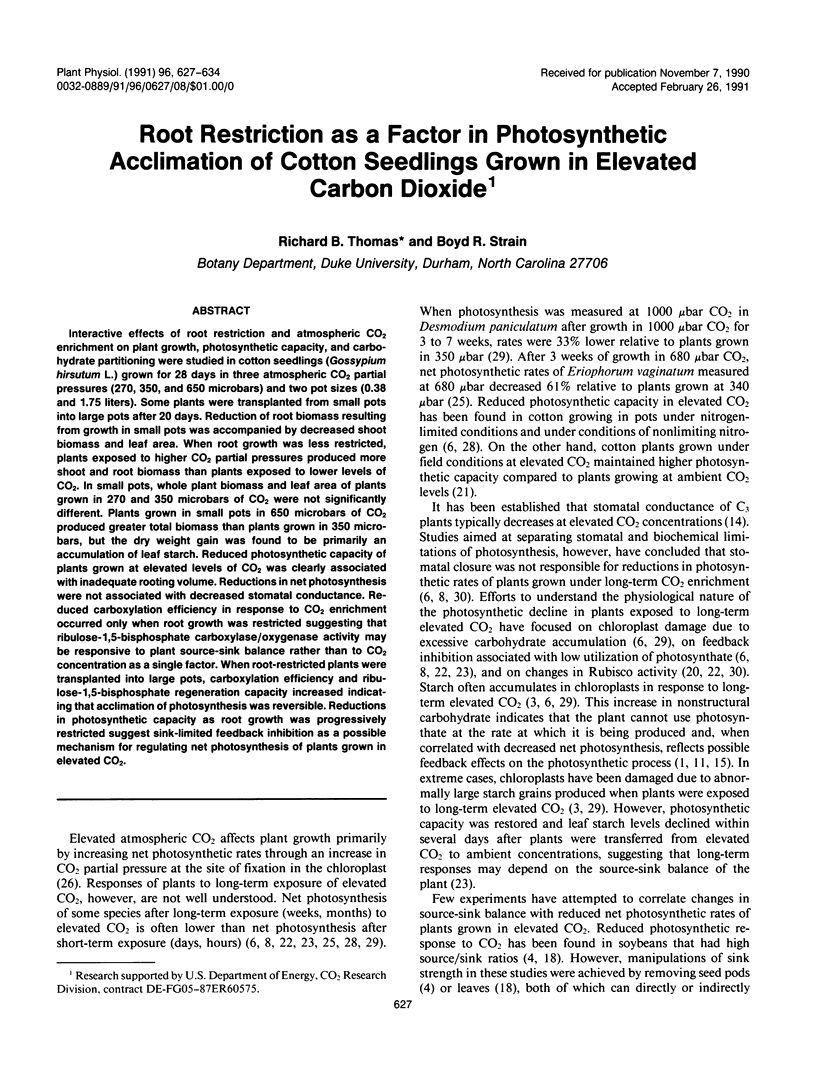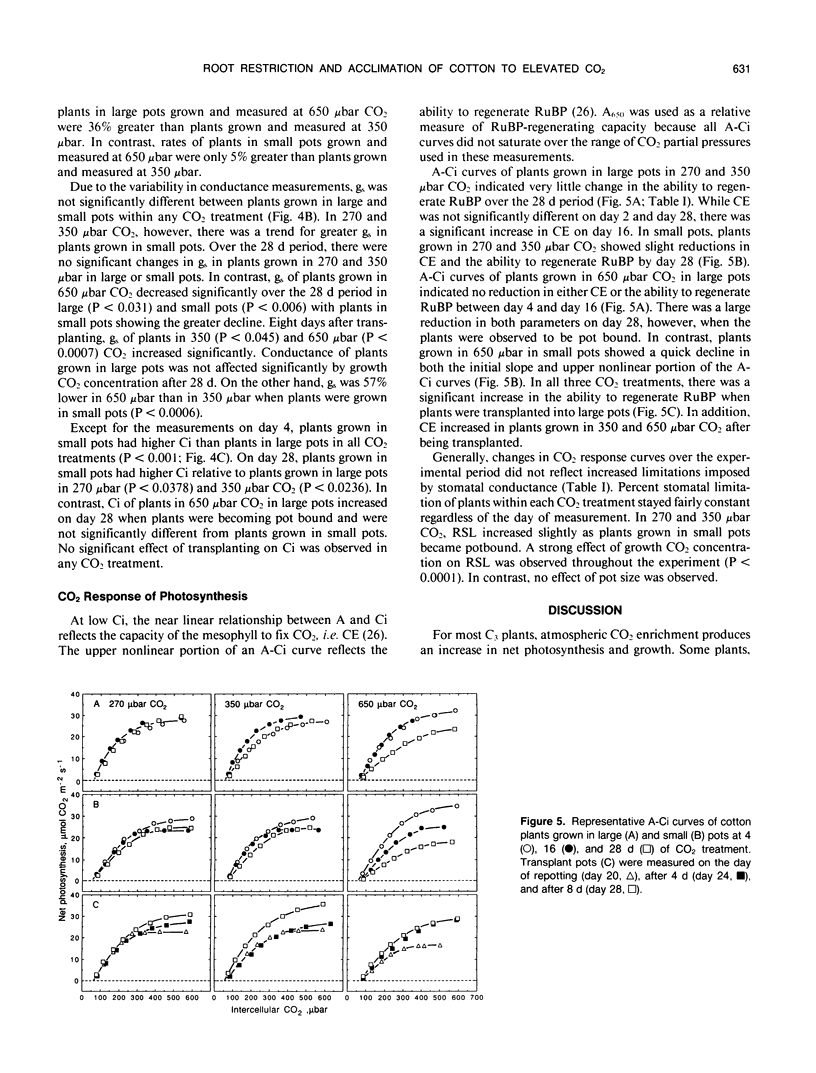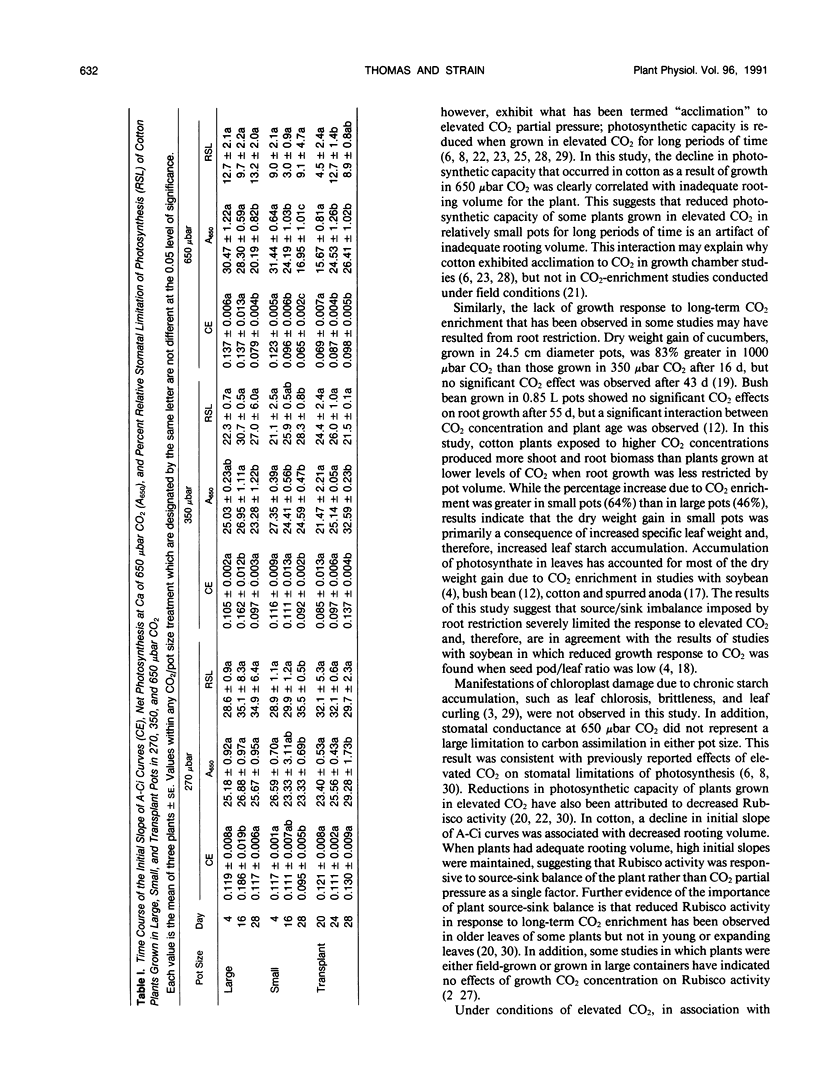Abstract
Interactive effects of root restriction and atmospheric CO2 enrichment on plant growth, photosynthetic capacity, and carbohydrate partitioning were studied in cotton seedlings (Gossypium hirsutum L.) grown for 28 days in three atmospheric CO2 partial pressures (270, 350, and 650 microbars) and two pot sizes (0.38 and 1.75 liters). Some plants were transplanted from small pots into large pots after 20 days. Reduction of root biomass resulting from growth in small pots was accompanied by decreased shoot biomass and leaf area. When root growth was less restricted, plants exposed to higher CO2 partial pressures produced more shoot and root biomass than plants exposed to lower levels of CO2. In small pots, whole plant biomass and leaf area of plants grown in 270 and 350 microbars of CO2 were not significantly different. Plants grown in small pots in 650 microbars of CO2 produced greater total biomass than plants grown in 350 microbars, but the dry weight gain was found to be primarily an accumulation of leaf starch. Reduced photosynthetic capacity of plants grown at elevated levels of CO2 was clearly associated with inadequate rooting volume. Reductions in net photosynthesis were not associated with decreased stomatal conductance. Reduced carboxylation efficiency in response to CO2 enrichment occurred only when root growth was restricted suggesting that ribulose-1,5-bisphosphate carboxylase/oxygenase activity may be responsive to plant source-sink balance rather than to CO2 concentration as a single factor. When root-restricted plants were transplanted into large pots, carboxylation efficiency and ribulose-1,5-bisphosphate regeneration capacity increased indicating that acclimation of photosynthesis was reversible. Reductions in photosynthetic capacity as root growth was progressively restricted suggest sink-limited feedback inhibition as a possible mechanism for regulating net photosynthesis of plants grown in elevated CO2.
Full text
PDF







Selected References
These references are in PubMed. This may not be the complete list of references from this article.
- Azcón-Bieto J. Inhibition of photosynthesis by carbohydrates in wheat leaves. Plant Physiol. 1983 Nov;73(3):681–686. doi: 10.1104/pp.73.3.681. [DOI] [PMC free article] [PubMed] [Google Scholar]
- Campbell W. J., Allen L. H., Bowes G. Effects of CO(2) Concentration on Rubisco Activity, Amount, and Photosynthesis in Soybean Leaves. Plant Physiol. 1988 Dec;88(4):1310–1316. doi: 10.1104/pp.88.4.1310. [DOI] [PMC free article] [PubMed] [Google Scholar]
- Clough J. M., Peet M. M., Kramer P. J. Effects of High Atmospheric CO(2) and Sink Size on Rates of Photosynthesis of a Soybean Cultivar. Plant Physiol. 1981 May;67(5):1007–1010. doi: 10.1104/pp.67.5.1007. [DOI] [PMC free article] [PubMed] [Google Scholar]
- Peet M. M. Acclimation to High CO(2) in Monoecious Cucumbers : I. Vegetative and Reproductive Growth. Plant Physiol. 1986 Jan;80(1):59–62. doi: 10.1104/pp.80.1.59. [DOI] [PMC free article] [PubMed] [Google Scholar]
- Porter M. A., Grodzinski B. Acclimation to High CO(2) in Bean : Carbonic Anhydrase and Ribulose Bisphosphate Carboxylase. Plant Physiol. 1984 Feb;74(2):413–416. doi: 10.1104/pp.74.2.413. [DOI] [PMC free article] [PubMed] [Google Scholar]
- Sage R. F., Sharkey T. D., Seemann J. R. Acclimation of Photosynthesis to Elevated CO(2) in Five C(3) Species. Plant Physiol. 1989 Feb;89(2):590–596. doi: 10.1104/pp.89.2.590. [DOI] [PMC free article] [PubMed] [Google Scholar]
- Sasek T. W., Delucia E. H., Strain B. R. Reversibility of Photosynthetic Inhibition in Cotton after Long-Term Exposure to Elevated CO(2) Concentrations. Plant Physiol. 1985 Jul;78(3):619–622. doi: 10.1104/pp.78.3.619. [DOI] [PMC free article] [PubMed] [Google Scholar]
- Yelle S., Beeson R. C., Trudel M. J., Gosselin A. Acclimation of Two Tomato Species to High Atmospheric CO(2): II. Ribulose-1,5-Bisphosphate Carboxylase/Oxygenase and Phosphoenolpyruvate Carboxylase. Plant Physiol. 1989 Aug;90(4):1473–1477. doi: 10.1104/pp.90.4.1473. [DOI] [PMC free article] [PubMed] [Google Scholar]


